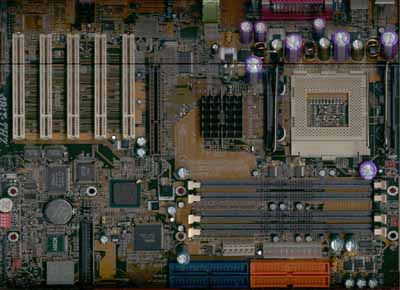Intel 850 Motherboard Roundup: September 2001
by Mike Andrawes on September 12, 2001 12:00 PM EST- Posted in
- Motherboards
ABIT TH7
|
ABIT TH7 |
|
|
CPU
Interface
|
Socket-423
|
|
Chipset
|
Intel
850/ICH2
|
|
Form
Factor
|
ATX
2.03
|
|
Bus
Speeds
|
90 / 100 / 103 / 105 / 108 / 110 / 112 / 115 / 118 / 120 / 122 / 125 / 130 / 133 / 136 / 138 / 140 / 142 / 145 / 148 / 150 / 152 / 154 / 156 MHz |
|
Voltages
Supported
|
Auto
Detect |
|
Memory
Slots
|
4
184-pin RIMM Slots
|
|
Expansion
Slots
|
1
AGP Slot |
|
On-board
Audio
|
Avance
Logic ALC200
|
|
BIOS
|
Award
Modular BIOS 6.00PG
|
When we received the ABIT TH7 we were pleasently surprised by some of the new features they added to the board. ABIT has always been known for providing the best overclocking results, which is exactly what most hardware enthusiasts like about ABIT. The TH7 again offers a wide range of overclocking features.
When we booted up the system for the first time, we noticed that ABIT has gone back to SoftMenu II for the TH7 rather than the SoftMenu III we’d seen on most recent boards, meaning that some features, such as 1MHz increments for FSB, are missing. This won’t hurt ABIT too much since none of the i850 boards we tested offer 1MHz increments anyways, and the TH7 offers the most FSB speeds anyway (tied with the ASUS P4T).
The board also offers a very wide range of CPU core voltages, the most flexible of any i850 board we’ve seen. On the other hand, there’s no I/O voltage tweaking, which has proved useful at times in maintaining stability of the system at high FSB speeds. During our overclocking tests we were able to push the board to run at 145MHz without compromising stability, tied for the best result among the boards here, again with the ASUS P4T.

The TH7 diverges from the Intel reference design for the CPU’s HSF mounting mechanism. The reference design requires you to manually install two separate metal brackets on each side of the HSF to lock it in place. The TH7 was the first board that arrived in our labs with a new design, where both metal brackets are actually lever shaped, allowing you to lock the HSF in place just like installing a CPU. These two HSF brackets are mounted to the motherboard with plastic clips, so you won’t need a new case.

Like all other recent ABIT products, the board features the Highpoint HPT370 IDE RAID controller, providing IDE RAID functionality via two additional Ultra ATA100 channels. The controller supports RAID 0, RAID 1, and RAID 0+1, or you can just use it as a standard IDE controller.
One neat new feature we found on the TH7 is a diagnostic tool similar to that found on some EPoX boards. During the boot up process the two digit display with show two hexadecimal numbers, corresponding to the initialization steps the motherboard is making. If the boot up is successful, the display will show FF. If the system fails during startup, you can refer to the manual for the error code to help determine what went wrong. This feature is especially useful when you are overclocking your system, so you can pinpoint the bottleneck of your system for the best overclocking result.

Another interesting feature we found on the TH7 are the two buttons beside the diagnostic display. One of these buttons acts as a power switch while other is a reset switch. Although this might not be too useful for normal usage, it’s very helpful when debugging a board on a bench. Note that there are standard power and reset button headers on the board as well for hooking up to your case’s buttons.

Instead of the standard two USB ports you usually find on the ATX I/O panel, ABIT has included a total of three ports. The board also has an integrated ALC200 AC’97 CODEC. Last of all, we also noticed the silk screen for the single-chip Texas Instrument IEEE 1394 Firewire setup. Although we haven’t seen a TH7 board actually incorporate this feature, it may be coming in the future.

Overall, the TH7 once again shows how dedicated ABIT is towards the hardware community, as evidenced by the variety of overclocking options that yielded very good results for us. To top it off, the board now features a much better diagnostic tool for better troubleshooting.











2 Comments
View All Comments
sabboo - Thursday, February 11, 2021 - link
This was the board in my first pc. As a student it was a very basic setup but got me through uni. I spent money on it and pushed the processor as far as it could go. I had upgraded the memory but it was beyond my financial means to do anything great at the time. Tomorrow I pull it out of the loft and see what I can buy to make this the ultimate gaming machine of its time. Any suggestions on pci cards to amke this an amazing addtion to my home network would be appreciated.infinitebritt - Thursday, March 25, 2021 - link
Amazing to see a comment about the D850GB in 2021. I use this motherboard TODAY for work. My work machine has not been plugged into the net since 2006. I have not installed or changed anything. It should run FOREVER. I made some money with crypto this year so I'm looking to spend $100-$200 to replace the ATX case with something smaller and quieter. The case I've been using for 15+ years is HUGE and LOUD